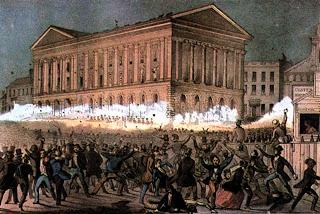 Antebellum America's bloodiest riot wasn't caused by cloistered convents, school Bibles or papal nuncios. While inflamed and exploited by Nativist rowdies, the Astor Place Riot of 1849 stemmed from the feud between two Shakespearean stars. Thirty-one people died because Americans couldn't stand a British actor performing Macbeth in their backyard.
Antebellum America's bloodiest riot wasn't caused by cloistered convents, school Bibles or papal nuncios. While inflamed and exploited by Nativist rowdies, the Astor Place Riot of 1849 stemmed from the feud between two Shakespearean stars. Thirty-one people died because Americans couldn't stand a British actor performing Macbeth in their backyard. William Charles Macready was the offending thespian. England's preeminent stage star, he alternated contemporary roles with Shakespeare; among his achievements was restoring the original text of King Lear, removing Nahum Tate's happy ending. He toured America and France, portraying Othello, Henry V and Macbeth (his signature role) to considerable acclaim. An exemplar of Shakespearean refinement, Macready was a fitting ambassador for English acting.
While touring America in 1826, he first encountered Edwin Forrest, an American actor making his mark as Mark Antony in Julius Caesar. Wildly successful among native viewers, Forrest left Macready unimpressed. He castigated Forrest's "vehemence and rude force" and claimed "he had not rightly understood some passages in the text." Not for him Forrest's colonial crudeness; he preferred the discriminating applause of the Park Theatre, whose rich audiences could appreciate a true Shakespearean.
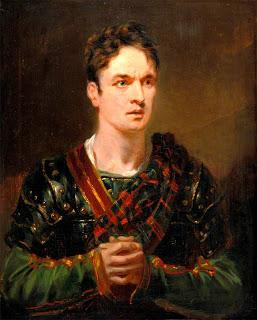
William Macready as Macbeth
While Macready courted high-born New Yorkers at the Park, Forrest entertained the Bowery's proletariat viewers. His raucous, physical acting, honed in Philadelphia street theaters and minstrel shows, more engaged Americans than Macready's mannered playing. Witnessing Forrest's Othello, Walt Whitman remarked on the "electric force and muscle from perhaps two thousand full-sinew'd men" cheering the actor's distinctly American style.Since the actors moved in difference circles, it took decades for their relationship to evolve from indifference to hate. It came in 1836, when Forrest traveled to England, playing Spartacus in Robert Montgomery Bird's The Gladiator. While Britons dismissed the play, they praised Forrest's acting, emboldening him to portray Othello. Enraptured by Forrest's unique histrionics, critics labeled the American "the most promising tragedian that has appeared in our day." Macready, himself playing Othello at the time, seethed.
Despite a cordial face-to-face meeting, the actors' animosity deepened as Forrest toured the provinces. Macready responded with a well-received tour of the United States, while Forrest's second stab at Othello met further acclaim. From critics, at least; English audiences began hissing and booing the American's performances. Forrest blamed Macready, who wasn't unhappy with this turn of events. "I am truly sorry for him, without wishing him great success," he remarked.

Edwin Forrest
The two actors continued crossing paths, their cordiality darkening into mutual hostility. The highpoint came in March 1846, when Macready played Hamlet at Edinburgh's Theatre Royal. Audience members hissed Macready; learning that Forrest was among them, Macready hastened to blame his rival. "The low-minded ruffian!" Macready seethed. "The man would commit murder if he could."Forrest further incensed Macready by defending his heckling to the London Times. "Mr. Macready thought fit to introduce a fancy dance into his performance of Hamlet, which I thought...a desecration of the scene." British audiences, previously favorable towards Forrest, now deserted him. The battle lines spread across the Atlantic, making Shakespeare a matter of national pride: classic Britons against upstart Americans. While Forrest himself might not commit murder, his followers weren't above inciting violence.
In fall 1848, Macready again toured the United States. Forrest, touring America as Othello, sniped at his rival in public letters, his foul mood inflamed by his imminent divorce from his English wife, Catherine. He blamed a "certain clique in London" for his falling out of favor with English audiences, attacking the London Examiner, who'd criticized Forrest's behavior, as the "hireling scribbler" of his rival. When Macready arrived in New York in April 1849, the stage was set.
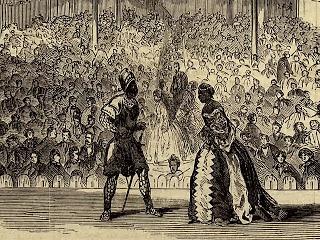
Macready considered terminating his tour, commenting acidly that "My concern was for the disgrace such people inflicted on the character of the country." It took a signed letter from 47 prominent New Yorkers, among them Washington Irving and Herman Melville, to persuade him to stay for one last performance. Authorities expected trouble, and Mayor Caleb S. Woodhull mobilized police to protect the theater. He also placed National Guard forces under General Charles W. Sandford& on standby.
Now domestic politics entered into the equation. Woodhull, a Whig, was nemesis to the Democrats' Tammany Hall establishment. Isaiah Rynders, a Democratic organizer, sought to embarrass Woodhull by prompting disorder. With the help of his assistant, Ned Buntline (later famed as a Western novelist), he spread handbills asking "Workingmen, Shall Americans or English Rule in This City?" Such sentiments escalated the situation from unpleasantness to violence.
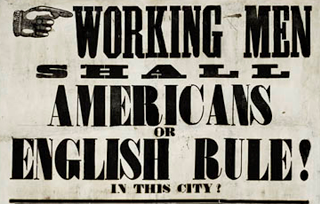
When Macready took the stage, theatergoers greeted him with a cacophonous ovation. Despite the efforts of ruffians to drown out the cheers, the demonstration lasted for fifteen minutes until management raised a placard reading "The friends of the Order will remain quiet." The play resumed, but the troublemakers continued their heckling, so loud that the play became inaudible. Police Chief George W. Matsell arrested six of the hecklers and locked them in the basement. The prisoners attempted to burn down the theater, but police extinguished the fire.
Events grew worse outside. The crowd uncovered a pile of paving stones, gathered for sewer construction, and at 8:00 the violence began. Rioters through stones through the theater windows, smashing glass and endangering the audience. They attempted to batter down the door, but police pushed them back with firehoses. The crowd redoubled their efforts, cornering the police against the wall and pelting them with stones.

George W. Matsell
Inside, while the play continued, Chief Matsell conferred with City Recorder Frederick A. Tallmadge and Sheriff Westervelt on a course of action. They decided to call out the militia, and General Sandford dispatched the Seventh Infantry Regiment to the theater. As they debated, the first fatality occurred; Thomas Kiernan, a 20 year old Irishman, was mortally injured by police. By now, per the New York Tribune, "the Opera House resembled a fortress besieged by an invading army rather than a place meant for the peaceful amusement of civilized community."At nine o'clock, Mayor Woodhull arrived with the first detachment of troops. He conferred with the officials already present, ordering the soldiers not to open fire until expressly ordered. This became difficult, as the mob turned their fury on the militia, pelting them with stones. The mob blocked General Sandford from deploying his cavalry; he ordered infantry to fix bayonets, a command which only emboldened the mob.
The violence momentarily abated, but the tension remained. Ned Buntline himself arrived, haranguing the crowd with inflammatory speechmaking: "Shall the sons whose fathers drove the baseborn miscreants from the shores give up their Liberty?" Another ruffian tore open his shirt, daring the soldiers to "take the life out of a free-born American for a bloody British actor!" Recorder Tallmadge made one last effort to remonstrate with the mob, which only inspired mockery.
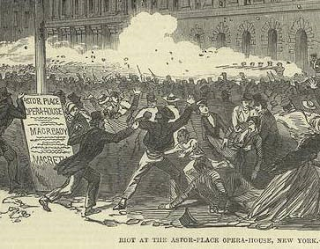
Finally, a ragged volley tore into the crowd, aimed at the rioters' legs and feet. Despite casualties, the mob continued their assault, forcing drastic action. "Fire obliquely!" came the next order, and the soldiers fired several volleys directly into the mob. Dozens fell, killed or wounded, and the mob panicked. Finally, the soldiers advanced with fixed bayonets, clearing the streets and arresting dozens of rioters.
Thirty-one men died in the riot, with over two hundred injured. Besides troublemakers, many innocent New Yorkers found themselves in the crossfire. John Clarke, a bookbinder watching the rioters from across the street, watched "a man [fall] nearly in front of me... he was shot through the left lung." George W. Gedney, also standing near Clarke, was shot through the head, dying instantly. His brother-in-law, among the soldiers defending the Astor Place, found the body and broke down, horrified that he may have killed Gedney.
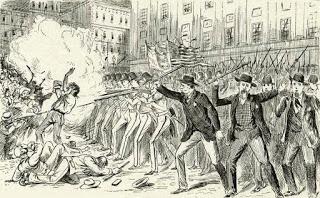
Tensions lingered on; the Astor Place remained closed for weeks. A mass rally in City Hall Park on May 11th attracted thousands; 2,000 soldiers patroled the city, which didn't prevent violence. Troublemakers set up a barricade in the streets and ambushed a patrol of dragoons, unhorsing two soldiers with marble blocks. Police overwhelmed the attackers, but not before killing a rioter. Several of the inciters, including Ned Buntline, received mild prison sentences for their role in the riot.
As for William Macready, he finished his performance and retired to his dressing room. Friends smuggled him out of the theater in disguise, along with terrified patrons, accompanied by a military guard. Macready went to Boston and fled America for England; he never set foot in the United States again, continuing his career until dying in 1873. Edwin Forrest remained one of America's premiere actors, rivaled only by Edwin Booth, until his death in 1872.
So inflamed were nineteenth Americans that Shakespeare could incite violence. Class and nationalism triggered a massive riot, all over the vanity of two brilliant, egotistical actors.
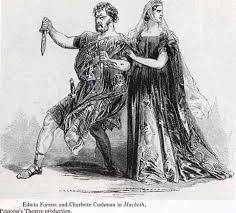
My account draws upon Richard Moody's book, The Astor Place Riot (1958). A more recent volume, Nigel Cliff's The Shakespeare Riots (2007), comes highly recommended but was unavailable to me.
Previous Articles on Know-Nothings and Nativists:
- The Charlestown Convent and the Birth of American Hate, 1834
- Philadelphia's Bible Battles, 1844
- Immigration, the Cardinal's Visit and the Resurgence of American Nativism, 1852-1854

